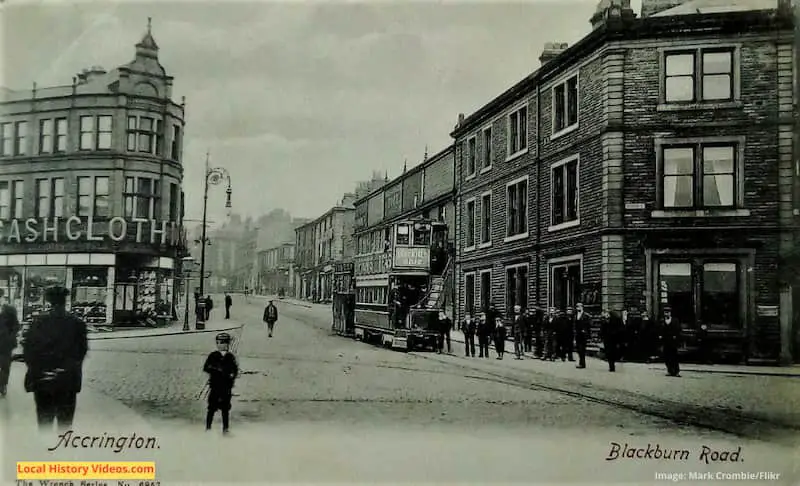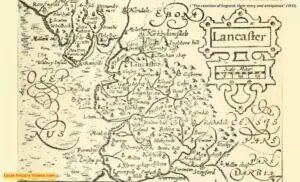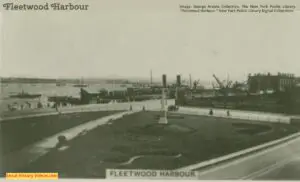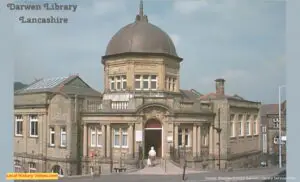Glimpse history through old images of Accrington, in the English county of Lancashire, UK.
The image of Blackburn Road at the top of this page is from a vintage postcard, dated to 1904.
On 11th June the same year, General Baden-Powell came to open Accrington’s Drill Hall. Today he is best remembered for setting up the worldwide scouting movement, but back in 1904 he was known as the defender of Mafeking during the Second Boer War in South Africa.
The St John Ambulance Brigade Headquarters had a doorway marked ‘HORSE AMBULANCE’.
After recording, the film was edited and prepared for an evening screening just hours later. That’s why so many people are included in the film, to entice more customers to attend in that evening in the hope they saw themselves on screen.
Opening of Drill Hall, Accrington by General Baden-Powell – BFI on YouTube
Electric Trams 1907
Three years later, the streets of this Lancashire town were ready to run the new electric tram system. Many people turned out to witness the new form of public transport on its launch.
The Mayor drives the tram along the short stretch towards the camera, his wife standing beside him.
A man places a board on the front of the tram, facing the camera, but gingerly removes it when the inspector walks round the front. Since the policeman was watching, I assume he had permission to do this, and his clothing suggests he may be a tram driver or conductor.
Some of the people don’t know whether to look at the tram or the film camera, both modern technology just emerging into everyday life.
Opening of Accrington Electric Tramways (1907) | Britain on Film – BFI on YouTube
1990s Town Centre
This 1990s home movie visits many different locations in and around Accrington’s town centre and the Accrington Arndale Centre.
You’ll see many shop signs which have long since disappeared.
AccringtonTownCentre (1990s) – Rob Jones on YouTube
Accrington Buses
These trailers for transport DVDs focus on the buses, but also capture the streets, businesses, cars and pedestrians of the time. You can buy the full DVDs from PMPfilms.
People of all ages appear, including children, so you may spot someone you know. There’s also quite a variety of streets shown across the different videos.
1989
ACCRINGTON BUSES 1989 – DaveSpencer32 on YouTube
1990
ACCRINGTON BUSES 1990 – DaveSpencer32 on YouTube
1992
ACCRINGTON BUSES 1992 – DaveSpencer32 on YouTube
1994
ACCRINGTON BUSES 1994 – DaveSpencer32 on YouTube
ACCRINGTON BUSES 1994 EXTRACTS FROM OUR ARCHIVE ON WIDE SCREEN BY DAVE SPENCER OF PMP- DaveSpencer32 on YouTube
1996
ACCRINGTON BUSES 1996- DaveSpencer32 on YouTube
1999
ACCRINGTON BUSES 1999 – DaveSpencer32 on YouTube
2000
ACCRINGTON BUSES 2000 – DaveSpencer32 on YouTube
2001
ACCRINGTON BUSES 2001- DaveSpencer32 on YouTube
Queen Elizabeth’s Visit
On 22nd May 2012, Queen Elizabeth II and the Duke of Edinburgh visited Accrington.
In the background you can see the Winners Adult Gaming site, Thomson travel agents, Quattro’s Italian Brasserie & Bar, and Blockbuster video store. This was the same year Netflix launched its streaming service in the UK.
The Queen visits Accrington – The Royal Family on YouTube
Historic Book
Extract from “Messrs. Hargreaves’ calico print works at Accrington, and recollections of Broad Oak ” by Benjamin Hargreaves
Published in 1882
Page 31
At the time of which I write , men of business had no convenient
way of getting to Manchester market except on horseback . There
were no coaches nor chaises , ( a chaise not being obtainable nearer
than Preston ) .
Small parties of gentlemen travelling from Burnley ,
Clitheroe , and Clayton – le – Moors , used to meet at the Hare and
Hounds at Enfield , and formed a little cavalcade . They were
joined on their way by others from Accrington and Haslingden ,
and rode to Manchester .
When business was finished they returned
in much the same order as they went . All who lived to the south
of Enfield left the party for their respective homes . The rest
journeyed onward and parted at the Hare and Hounds . It was a
four – lane – end rendezvous both going and returning . Many a
parting cup has been quaffed there , and many a loyal toast gone
round at that noted hostelry .
A change came over this mode of
travelling to the cotton emporium – no less than the starting of a
four horse coach from Clitheroe to Manchester . I shall never forget
the enthusiasm with which the first appearance of the Clitheroe
Coach ( as it was called ) , gaily bedecked and caparisoned , was
greeted on its first traversing the principal street or thoroughfare
of the town . The road was lined with spectators , three or four file
deep , and shout after shout burst forth from the delighted in
habitants of the town and neighbourhood assembled .
After some
years other coaches were established , and travelling to Manchester
market on horseback became a thing of the past .
Pages 41-44
In the spring of 1826 , my brother Robert being in the works , I
went to Mr. Dalton , of Manchester , to improve myself in calculation ,
in which I was sadly deficient …..
These lessons continued six months ,
but before they were finished there broke out over North – East
Lancashire one of those wild theorisms that overwhelm all reason ,
like the out – pourings of a volcano , that the power – loom ( then just
coming into use ) was destroying the hand – loom weavers .
The
latter had suffered long and patiently , and for a few years my
mother’s door had been beset with supplicant weavers from Padiham ,
Colne , and the neighbourhood . My mother being a truly unself
ish , charitable woman , gave them sixpences , oat – meal , and bacon ,
and did her best to allay their temporary wants .
It was , to the best of my recollection , the month of May 1826 ,
that a huge mob of some three or four thousand men , woman , and
lads , armed with cudgels , sledge – hammers , crowbars and scythes ,
were seen coming into Accrington . They marched direct to
Messrs . Sykes ‘ mill , at the Grange .
My brother Robert hearing
that a mob was coming , and having an intimation what it was after ,
hastened to the mill and hid himself behind the chimney of a house
near at hand and saw all that passed .
The first thing was that of
a woman smashing a clock that hung in the passage . The next
was an onslaught on the looms with crowbars and sledge – hammers .
These disappeared like potteryware , and all was finished in the way
of destruction . A consultation was held , at which the question
was put ” Shall we go to Broad Oak ? ” It was decided not to go ,
for Mrs. Hargreaves , they said , had always been kind . Thus , as
an aunt of ours once remarked , ” Your mother’s meal and bacon
saved Broad Oak . “
Now as there were no power looms at Broad Oak , to have
destroyed the machinery would have been going beyond the
province of power – loom breaking . The mob , triumphant at
Accrington , next visited White Ash , destroying everything
connected with power – loom weaving . From thence they proceeded
to Blackburn and Haslingden , demolishing every power – loom they
could find .
The agitation went on for a week , spreading to Bury ,
Oldham , and Manchester , and would have augmented at a fearful
rate , but at Chatterton they were met by about twenty riflemen ,
and the Riot Act having been read , a volley was fired amongst
the rioters , and five or six of them killed . This was a check to such
mobism , and outlawism soon ceased .
It took the county by sur
prise , when it was called upon to pay the piper for all this destruc
tion of property . The distress in North – East Lancashire was still
great ; power – loom breaking had done no good , serving only to
destroy confidence , and throw back any hopes of improvement .
The Government came forward , offering loans of money for public
works to employ the unemployed . Mr. McAdam , a noted surveyor
and improver of road construction , came down to Blackburn , to see
what could be undertaken in the way of public works , and all who
had anything to suggest were invited to wait upon him .
A public
meeting was held at Accrington , at which it was suggested that a
new and direct road to Blackburn was desirable . The late Rev.
John Hopwood , then incumbent of St. James ‘ Church , and myself
( for I had returned from Manchester ) , were deputed to wait upon
Mr. McAdam . We did so , and the scheme being regarded in a
favourable light , a loan was granted , and the work commenced .
Ultimately the road was handed over to the Bury and Whalley
Trust Commission , and the money advanced by Government re
funded by the commissioners , who had the privilege of collecting
the tolls , until the Act of Parliament , under which the trust was
held , expired .
This road was found the greatest benefit to Accring
ton and the neighbourhood , and was followed in a few years by the
Burnley road , constructed by the Blackburn and Addingham Trust
Commissioners .
In a former paper I have spoken of the building of Warner street
being thought a great thing . The reader may imagine what Accring
ton was without Culvert – street , Oak – street , Blackburn – road , and
Peel – street , which last was only a private carriage road from
Accrington House to St. James ‘ Church .
Whilst treating of
Accrington , I may mention that , a few years before my father
purchased Grange estate from John Duckworth ( better known as
Jackey Duckworth ) , there was a row of fine pine trees ( Pinus
Asturus ) where the north wall of Christ Church now stands . These
were cut down , I imagine to make a little money before my father’s
purchase . There were also one or two of the same description of
trees behind the old house now standing at Grange , but these
gradually died away from old age . Such pine trees are generally
found about monastic ruins , and speak volumes for the Grange
having been what it has traditionally been represented from times
immemorial , a Grange to Kirkstall Abbey . This being assumed ,
we may well believe what it was represented historically , to have
been the site of a monastic grange erected by an abbot of Kirkstall .
This monastic institution having been burnt down and the poor
monks massacred some hundred years ago , has left legacies or
mementoes in the names of Grange , Black Abbey , Priest Heys , and
Abbey – street .
More about Lancashire
- Old Images of Lancashire, England
- Old Images of Skelmersdale, Lancashire
- Old Images of Haslingden, Lancashire
- Old Images of Fleetwood, Lancashire
- Old Images of Darwen, Lancashire
More about Lancashire local history resources
Back to home page





